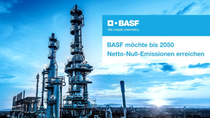While enabling our customers’ green transformation, we keep fully committed to our climate protection targets
Sustainability
Sustainability Targets
We are pursuing a profitable path for change and are firmly committed to achieving our climate targets for 2030 and 2050. Climate protection is a key component of our corporate strategy.
As an energy-intensive company, we bear responsibility for global climate protection and support the Paris Climate Agreement. We continue to strive to achieve our climate targets with our strategy.
Compared to the base year 2018, we plan to reduce greenhouse gas emissions from our production processes (Scope 1) and our energy procurement (Scope 2) by 25% by 2030. This corresponds to a reduction of around 60% compared to 1990. We also have ambitious Scope 3 targets for specific raw material-related emissions.
By 2030, we want to specifically reduce these in relation to purchasing volumes. Our long-term goal is net-zero greenhouse gas emissions by 2050 (Scope 1, 2 and 3). By 2030, we expect demand for sustainable products to exceed supply, which could lead to an increasing willingness to pay. This will contribute to profitable growth for BASF.
With the increasing growth in the markets for sustainable products, we will be able to expand and apply the new technologies that we are currently testing in pilot projects. We plan to increase the share of Sustainable Future Solutions in BASF Group sales from 41% (2023) to over 50% (2030) and to increase Loop Solutions sales from €5 billion in 2023 to €10 billion by 2030. We expect most of the major investments for our green transformation to be made after 2030.

1 Scope 1 and Scope 2 (excluding sale of energy to third parties); greenhouse gas emissions according to Greenhouse Gas Protocol, converted into CO2 equivalents (CO2e)
2 Corresponds to a reduction from 1.64 to 1.39 kilograms of CO2 equivalents per kilogram of raw material bought; Scope 3.1, raw materials excluding battery materials, excluding services, technical goods and greenhouse gas emissions from BASF trading business. In 2024 we adjusted the baseline in line with the TfS guideline due to the availability of further primary data.
3 TripleS: Sustainable Solution Steering methodology for steering the product portfolio based on sustainability criteria; not included: platinum group metals within ECMS, strategically non-relevant businesses such as IT services, licenses, etc.
4 “Others” comprises health and safety, pollution reduction, biodiversity, water protection and zero hunger.



